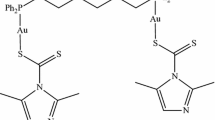Abstract
6-125I-iodo-2-methyl-1,4-naphthoquinol bis (diammonium phosphate) (6-125I-iodo-MNDP) has been synthesised and studied as the prototype of a class of potential radio-halogenated anti-cancer agents. The incorporated 125I provides Auger electron radiations which behave like high LET radiations in the treatment of tumours, though the accompanying X- and γ-radiations make an undersirable contribution to the total body dose. The in vitro experiments reported show that 6-125I-iodo-MNDP is selectively concentrated in the cells of some human malignant tumours by factor of about 15 to 20 or more in relation to the cells of normal origin studied. On the basis of dosimetric considerations and comparison with clinical treatment with tritiated methylnaphthoquinol diphosphate, practical dosage of 6-125I-iodo-MNDP is suggested and clinical indications and safety of use are discussed. The types of tumour of particular interest are inoperable cases of carcinoma of the colon, carcinoma of the pancreas, malignant melanoma and osteosarcoma. Further investigations are in progress.
Similar content being viewed by others
References
Brown I, Mitchell JS (1979) 6-125I-iodo-2-methyl-1,4-naphthoquinol bis (diammonium phosphate); a new potential anti-tumour drug. J Chem Soc Chem Comm 659–660
Brown I, Mitchell JS, Dawson MP. A, Harding RE, Carpenter RN (1979) Investigation of 6-125I-iodo-2-methyl-1,4-naphthaquinol bis (diammonium phosphate) (6-125I-MNDP) as a radioactive drug. 6th International Congress of Radiation Research, Tokyo, Abstract No. E-3-6, p 252
Brown I, Mitchell JS, Carpenter RN (1980) Radiochemotherapy —The potential use of incorporated Auger emitters in suitable organic molecules. Proc Canadian Inst of Chemistry. Chemical Conference: Symposium on human cancer, Ottawa, Abstract B10-36, pp 53–54
Brown I (1981) 6-211At-astato-2-methyl-1,4-naphthoquinol bis(disodium phosphate): a novel-emitting anti-tumour drug. Int J Appl Rad Isotopes (in press)
Chan PC, Lisco E, Lisco H and Adelstein SJ (1976) The radio-toxicity of iodine-125 in mammalian cells. II. A comparative study on cell survival and cytogenetic responses to 125IUdR, 131IUdR and 3HTdR. Radiat Res 67:332–343
Chapman JD, Sturrock J, Boag JW, Crookall JO (1970) Factors affecting the oxygen tension around cells growing in plastic Petri dishes. Int J Radiat Biol 17:305–328
Charlton DE, Booz J, Fidorra J, Smit Th, Feinendegen LE (1978) Microdosimetry of radioactive nuclei incorporated into the DNA of mammalian cells. In: Booz J, Ebert HG (eds) Sixth Symposium on Microdosimetry, Brussels, Belgium, 1978, Harwood Academic Publishers Ltd. London, for the Commission of the European Communities, Brussels and Luxembourg, pp 91–110
Eagle H (1955) Propagation in a fluid medium of a human epidermoid carcinoma, strain KB. Proc Soc Exp Biol Med 89:362–364
Feige Y, Gavron A (1975) Microdosimetry of Auger electrons. In: Nygaard OF, Adler HL, Sinclair WK (eds) Radiation Research Biomedical, Chemical and Physical Perspectives. Academic Press New York, San Francisco, London, pp 557–569
Franks LM, Hemmings GT (1978) A cell line from an induced carcinoma of mouse rectum. J Pathol 124:35–38
Gillespie FC, Orr JS, Greig WR (1970) Microscopic dose distribution from 125I in the toxic thyroid gland and its relation to therapy. Br J Radiol 43:40–47
Hofer KG, Hughes WL (1971) Radiotoxicity of intranuclear Tritium 125Iodine and 131Iodine. Radiat Res 47:94–109
Hofer KG, Keough G, Marshall Smith J (1977) Biological toxicity of Auger emitters; molecular fragmentation versus electron irradiation. Curr Top Radiat Res 12:335–352
Hughes WL, Gitlin D (1955) Astatinated (At211) organic compounds for production of highly localized radiobiological effects. Fed Proc 14:229
ICRP Publication 26 (1977) Recommendations of the International Commission of Radiological Protection. Annals of the ICRP 1:No. 3, 21
Marrian DH, Mitchell JS, Bull CH, King EA, Szaz KF (1969) Labelled compoud related to Synkavit and its uptake in certain human tumours studied by radio-isotope scanning. Acta Radiol [Ther] (Stockh) 8:221–246
Mays CW (1970) Discussion in late effects of radiation. In: Fry RIM, Grahn D, Griem M, Rust JH (eds) Late effects of radiation. Taylor & Francis, London, p 220
Mitchell JS (1970) Über die Möglichkeit der Entwicklung radioaktiver Pharmaka. In: Braun H, Heuck F, Ladner H-A, Messerschmidt O, Rausch L (eds) Fortschritte im Strahlenschutz. Georg Thieme Verlag, Stuttgart, pp 1–34
Mitchell JS (1971a) Cancer if curable, why not cured? W Heffer & Sons Ltd., Cambridge, pp 47, 65–67, 71–74
Mitchell JS (1971b) Neuere Untersuchungen zur Frage der therapeutischen Anwendungen von tritium-markierten organischen Substanzen. Atomkernenergie. (ATKE) 18:109–114
Mitchell JS (1974) Investigations of tritiated menadiol sodium diphosphate (T-MNDP) as a radioactive drug. Br J Cancer 29:373–388
Mitchell JS, King EA, Marrian DH, Chipperfield B (1963) Investigation of a radioactive drug (TRA119) with special reference to autoradiographic and related studies. Acta Radiol [Ther] (Stockh) 1:321–350
Mitchell JS, Marrian DH (1965) Radiosensitization of cells by a derivative of 2-methyl-1,4-naphthoquinone, in Biochemistry of Quinones, Ed. R A Morton, Academic Press, London New York, Chap 15, pp 503–541
Netter H (1959) Theoretische Biochemie. Springer, Berlin Göttingen Heidelberg, pp 225–226
Paul J (1975) Cell and Tissue Culture, 5th. Churchill Livingstone, Edinburgh London New York, p 226
Reddy AR, Kaul A (1978) Microscopic dose distributions due to iodine isotopes in thyroid. Radiat Environ Biophys 15:229–239
Rössler K, Meyer G-J, Stöcklin G (1976) Labelling and animal distribution studies of 5-astatouracil and 5-astatodeoxyuridine (211At) J Lab Comp Radiopharm 133:271
Spiess H, Mays CW (1970) Bone cancers induced by 224-Ra(ThX) in children and adults. Health Phys 19:713–729
Toolan HW (1954) Transplantable human neoplasms maintained in cortisone-treated laboratory animals: H.S. No. 1; H.Ep No. 2; H.Ep. No. 3; and H.Emb. Rh. No. 1. Cancer Res 14:660–666
UNSCEAR (1977) United Nations Scientific Committee on the Effects of Atomic Radiation: Sources and effect of ionizing radiations; 1977 Report to the General Assembly, with Annexes. United Nations, New York, pp 363, 371, 385, 409, 414
Author information
Authors and Affiliations
Additional information
Beit Memorial Fellow for Medical Research
Rights and permissions
About this article
Cite this article
Brown, I., Carpenter, R.N. & Mitchell, J.S. 6-125I-iodo-2-methyl-1,4-naphthoquinol bis (diammonium phosphate) as a potential radio-halogenated anti-cancer agent: In vitro investigations and possible clinical implications. Eur J Nucl Med 7, 115–120 (1982). https://doi.org/10.1007/BF00256398
Received:
Issue Date:
DOI: https://doi.org/10.1007/BF00256398



